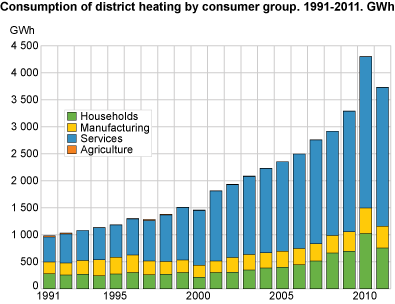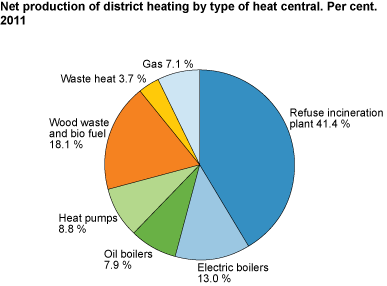Content
Published:
This is an archived release.
Reduced consumption of district heating
District heating consumption decreased by 13.3 per cent in 2011 and equalled 3.7 TWh. The reduction can partly be explained by the relatively mild weather during the period. The average temperature was almost 3 degrees higher in 2011 than in the relatively cold year of 2010.
Households reduced their district heating consumption the most. For this group, the volume of district heating consumed was reduced by 26.3 per cent and amounted to 754 TWh. Manufacturing reduced district heating consumption by 14.8 per cent. In total, 401 GWh was delivered to the manufacturing industry in 2011. In the service industry, which had the largest share of district heating consumption in 2011, the district heating consumption was reduced by 8.3 per cent and totalled 2.6 TWh.
District heating accounts for about 2 per cent of the net domestic consumption of energy in total. (See Preliminary Energy Balance, 2011 ).
Lower sales income in spite of price increases
The average district heating price increased by 4.8 per cent in 2011 and equalled 68.2 øre/KWh (excluding VAT). In spite of higher prices, the decrease in the district heating consumption resulted in 10 per cent lower sales income than in 2010. Sales income amounted to NOK 2.5 billion in 2011.
Over 40 per cent of district heating production comes from refuse incineration
Refuse incineration was the most important input factor in district heating production, amounting to 41.4 per cent of the total production. This is an increase of 9 percentage points since 2010. Wood waste and bio fuel accounted for 18.1 per cent, while electric boilers accounted for 13 per cent of the district heating production in 2011. The share of oil boilers in production decreased by 6.2 percentage points compared to 2010. This may partly be a result of the average price increase of light heating oil from 820 to 971 øre/litre (see Petroleum product sales in 2011 ).
| 2010 | 2011 | Change in per cent | |||||||||||||||||||||||||||||||||||||||||||||||||||||||||||||||||||||||||||||
|---|---|---|---|---|---|---|---|---|---|---|---|---|---|---|---|---|---|---|---|---|---|---|---|---|---|---|---|---|---|---|---|---|---|---|---|---|---|---|---|---|---|---|---|---|---|---|---|---|---|---|---|---|---|---|---|---|---|---|---|---|---|---|---|---|---|---|---|---|---|---|---|---|---|---|---|---|---|---|---|
| Total net production | 4 833 | 4 237 | -12.3 | ||||||||||||||||||||||||||||||||||||||||||||||||||||||||||||||||||||||||||||
| Refuse incineration plant | 1 564 | 1 755 | 12.2 | ||||||||||||||||||||||||||||||||||||||||||||||||||||||||||||||||||||||||||||
| Oil boilers | 684 | 334 | -51.1 | ||||||||||||||||||||||||||||||||||||||||||||||||||||||||||||||||||||||||||||
| Wood waste and bio fuel | 899 | 767 | -14.7 | ||||||||||||||||||||||||||||||||||||||||||||||||||||||||||||||||||||||||||||
| Electric boilers | 662 | 550 | -16.9 | ||||||||||||||||||||||||||||||||||||||||||||||||||||||||||||||||||||||||||||
| Heat pumps | 414 | 374 | -9.7 | ||||||||||||||||||||||||||||||||||||||||||||||||||||||||||||||||||||||||||||
| Gas | 402 | 300 | -25.5 | ||||||||||||||||||||||||||||||||||||||||||||||||||||||||||||||||||||||||||||
| Waste heat | 208 | 157 | -24.4 | ||||||||||||||||||||||||||||||||||||||||||||||||||||||||||||||||||||||||||||
Net production decreased by 12.3 per cent
The gross production of hot water and steam was reduced by 4 per cent in 2011 and equalled 5.3 TWh. Of this, 273 GWh was used in the production of electricity and 797 GWh was non-distributed heat. This is an increase of 20 and 67 per cent respectively compared with 2010. The increase in the volume of non-distributed heat may be seen in conjunction with the start of new refuse incineration plants. In addition, the reduced district heating consumption in 2011 contributed to higher volumes of non-distributed heat. In total, net production of district heating was 4.2 TWh and losses in the distribution net equalled 508 GWh.
Slightly reduced investments
Investments decreased by 15 per cent in 2011 compared to 2010. The total investment was about NOK 3 billion, which is about the same level of investment as in 2009. Investments in production plants totalled NOK 2.2 billion in 2011, while investments in distribution amounted to NOK 0.8 billion. Other investments amounted to about NOK 51 million.
Tables:
Contact
-
Ann Christin Bøeng
E-mail: ann.christin.boeng@ssb.no
tel.: (+47) 40 81 13 58


